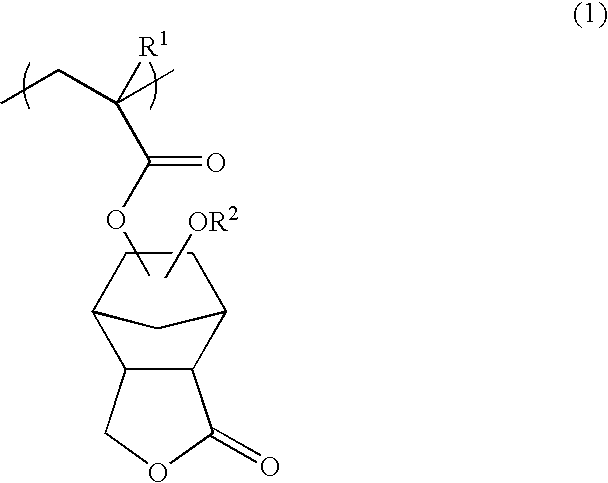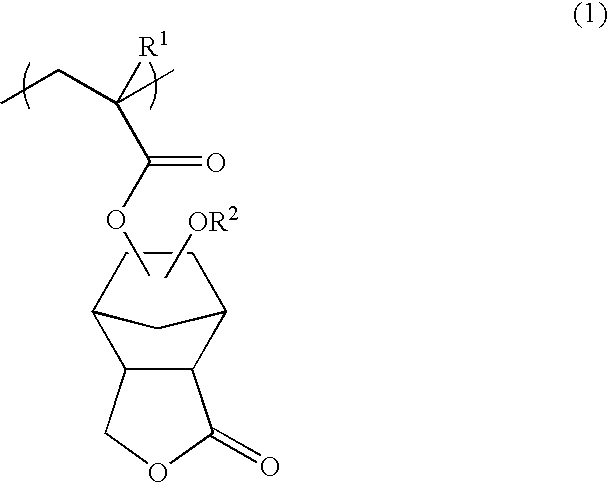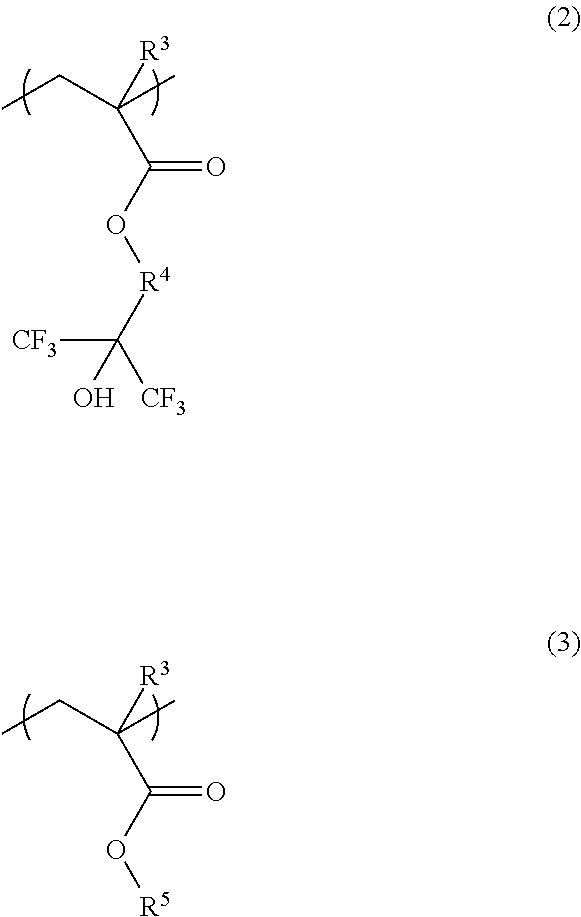Radiation-sensitive composition
a composition and radiation-sensitive technology, applied in the field of radiation-sensitive compositions, can solve the problems that the resolution performance cannot meet various requirements, and the yield of the device is significantly affected, and achieve the effects of low lwr, excellent basic resist performance, and high resolution
- Summary
- Abstract
- Description
- Claims
- Application Information
AI Technical Summary
Benefits of technology
Problems solved by technology
Method used
Image
Examples
synthesis example 1
Polymer (A-1)
[0248]A monomer solution was prepared by dissolving 27.51 g (50 mol %) of the compound (M-1), 5.29 g (15 mol %) of the compound (M-2), and 17.20 g (35 mol %) of the compound (M-3) in 100 g of 2-butanone, and further adding 1.72 g (5 mol %) of azobis(isobutylonitrile) (indicated as “AIBN” in Table 1).
[0249]A 500 ml three-necked flask equipped with a thermometer and a dropping funnel was charged with 50 g of 2-butanone and purged with nitrogen for 30 minutes. After the nitrogen purge, the flask was heated to 80° C. while stirring the contents using a magnetic stirrer, and the above monomer solution was added dropwise using a dropping funnel over 3 hours. The polymerization reaction was carried out for 6 hours after initiation of dropping.
[0250]After polymerization, the polymer solution was cooled with water to 30° C. or less. After cooling, the reaction mixture was poured into 1000 g of methanol, and a white powder which deposited was separated by filtration. The white po...
synthesis examples 2 to 6
Polymer (A-2) and Polymers (B-1) to (B-4)
[0254]Polymer (A-2) and polymers (B-1) to (B-4) were synthesized in the same manner as Synthesis Example 1, except for using components in amounts shown in Table 1. Dimethyl-2,2′-azobis-iso-butyrate (indicated as “MAIB” in Table 1) was used as an initiator in Synthesis Examples 3 to 6.
[0255]The ratio of the repeating units (mol %) determined by 13C-NMR analysis, yield (%), Mw, the molecular weight dispersion (Mw / Mn), and the amount of residual low-molecular-weight components in the polymer (A-1) and polymers (B-1) to (B-4) are shown in Table 2.
(Preparation of Radiation-Sensitive Compositions)
[0256]The composition of the radiation-sensitive compositions prepared in the Examples and Comparative Examples, and heating conditions before and after exposure (PB and PEB) are shown in Table 3. The components forming the radiation-sensitive compositions other than the polymers (A-1) and (A-2), and polymers (B-1) to (B-4) synthesized in the above Synthe...
example 1
[0264]100 parts by mass of polymer (A-1) obtained in Synthesis Example 1, 5.0 parts by mass of polymer (B-1), 7.0 parts by mass of triphenylsulfonium nonafluoro-n-butanesulfonate (C-1), 2.0 parts by mass of 1-(4-n-butoxynaphthalen-1-yl)tetrahydrothiophenium nonafluoro-n-butanesulfonate (C-2) as radiation-sensitive acid generators (C), and 1.12 parts by mass of N-t-butoxycarbonyl-4-hydroxypiperidine (D-1) as a nitrogen-containing compound (D) were mixed. 1400 parts by mass of propylene glycol monomethyl ether acetate (F-1) and 600 parts by mass of cyclohexanone (F-2) and 30 parts by mass of y-butyrolactone (F-3) as solvents (F) were added to the mixture to obtain a solution. The resulting solution was filtered through a filter with a pore diameter of 0.20 μm. The composition of the radiation-sensitive composition is shown in Table 3.
[0265]The above-described sensitivity (1), resolution (1), LWR (line roughness characteristics), sensitivity (2), resolution (2), pattern cross-section c...
PUM
| Property | Measurement | Unit |
|---|---|---|
| wavelength | aaaaa | aaaaa |
| wavelength | aaaaa | aaaaa |
| wavelength | aaaaa | aaaaa |
Abstract
Description
Claims
Application Information
 Login to View More
Login to View More - R&D
- Intellectual Property
- Life Sciences
- Materials
- Tech Scout
- Unparalleled Data Quality
- Higher Quality Content
- 60% Fewer Hallucinations
Browse by: Latest US Patents, China's latest patents, Technical Efficacy Thesaurus, Application Domain, Technology Topic, Popular Technical Reports.
© 2025 PatSnap. All rights reserved.Legal|Privacy policy|Modern Slavery Act Transparency Statement|Sitemap|About US| Contact US: help@patsnap.com



